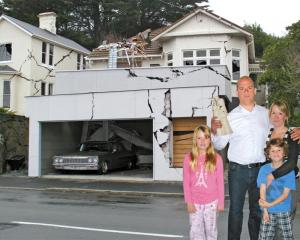
University of Otago geologists Dr Virginia Toy and Prof Norris gave an open lecture on "New Zealand Earthquakes and Earthquake Hazard in Dunedin" at the university's St David lecture theatre last night, during the university's latest annual Hands-on Science school.
Prof Norris acknowledged in an interview the level of overall earthquake hazard in Christchurch was about twice that of Dunedin.
He said Dunedin people should not be alarmist, or "panic". The city's overall seismic hazard level was relatively low, but it was wrong to think of it as perpetually stable.
"There's no reason for complacency in Dunedin.
"It does have these faults very close to the city, which Christchurch didn't know that it did. We know about ours."
Although much of the Dunedin central business district was built on solid rock, some unreinforced masonry buildings in the city could collapse in a major shake.
He noted the Akatore Fault line, part of which was situated at Taieri Mouth, last broke about 1000 years ago.
Recent offshore seismic imaging and ocean floor mapping by Callum Bruce, a BSc (Hons) geology student supervised by Dr Andrew Gorman, has helped clarify the offshore expression of the Green Island fault.
This fault, which could be seen near Black Head, linked to the Akatore system and ran towards the St Clair cliffs.
It was unknown how Dunedin's nearby faults would operate in the event of a big earthquake, including whether only one would break or whether this would later contribute to other nearby faults also moving, he said.
Dr Toy noted that New Zealand sat astride "the active Pacific-Australian tectonic plate boundary".
Further south, off Fiordland, the Australian plate subducted beneath the Pacific plate and some of New Zealand's largest recent earthquakes had occurred on this interface, she said.
Closer to home, the Akatore and Green Island faults were "capable of generating earthquakes that could be just as damaging in Dunedin as an Alpine Fault earthquake".
However, they slipped much less commonly than the Alpine Fault - every few thousand years, she said.
The Alpine Fault accommodated about 70% of the plate boundary motion, and the fault had a high - about 50% - chance of rupturing to generate a magnitude-8 earthquake in the next 50 years.
Otago scientists were in the initial stages of a major drilling project, to try to sample some of the fault rocks generated during earthquakes from depth, and measure the conditions, including stress and fluid pressure, at depths where earthquake ruptures started.
In the Mackenzie Country, faults such as the Ostler Fault slipped reasonably irregularly - every few thousand years - and were much less predictable than the Alpine Fault.
They accommodated the remaining 30% or so of the plate boundary motion. The Christchurch earthquakes were related to slips on this kind of fault, she said.
Advertisement




